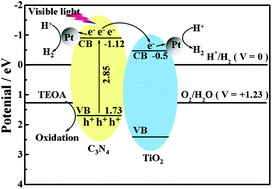Graphitic carbon nitride (g-C3N4)–Pt-TiO2 nanocomposite as an efficient photocatalyst for hydrogen production under visible light irradiation
Abstract
Porous graphitic carbon nitride (g-C3N4) was prepared by a simple pyrolysis of

* Corresponding authors
a
College of Chemistry and Molecular Science, Wuhan University, Wuhan 430072, China
E-mail:
typeng@whu.edu.cn, zanling1123@163.com
b College of Chemistry and Environmental Engineering, Wuhan Polytechnic University, Wuhan 430023, China
Porous graphitic carbon nitride (g-C3N4) was prepared by a simple pyrolysis of

 Please wait while we load your content...
Something went wrong. Try again?
Please wait while we load your content...
Something went wrong. Try again?
B. Chai, T. Peng, J. Mao, K. Li and L. Zan, Phys. Chem. Chem. Phys., 2012, 14, 16745 DOI: 10.1039/C2CP42484C
To request permission to reproduce material from this article, please go to the Copyright Clearance Center request page.
If you are an author contributing to an RSC publication, you do not need to request permission provided correct acknowledgement is given.
If you are the author of this article, you do not need to request permission to reproduce figures and diagrams provided correct acknowledgement is given. If you want to reproduce the whole article in a third-party publication (excluding your thesis/dissertation for which permission is not required) please go to the Copyright Clearance Center request page.
Read more about how to correctly acknowledge RSC content.
 Fetching data from CrossRef.
Fetching data from CrossRef.
This may take some time to load.
Loading related content
